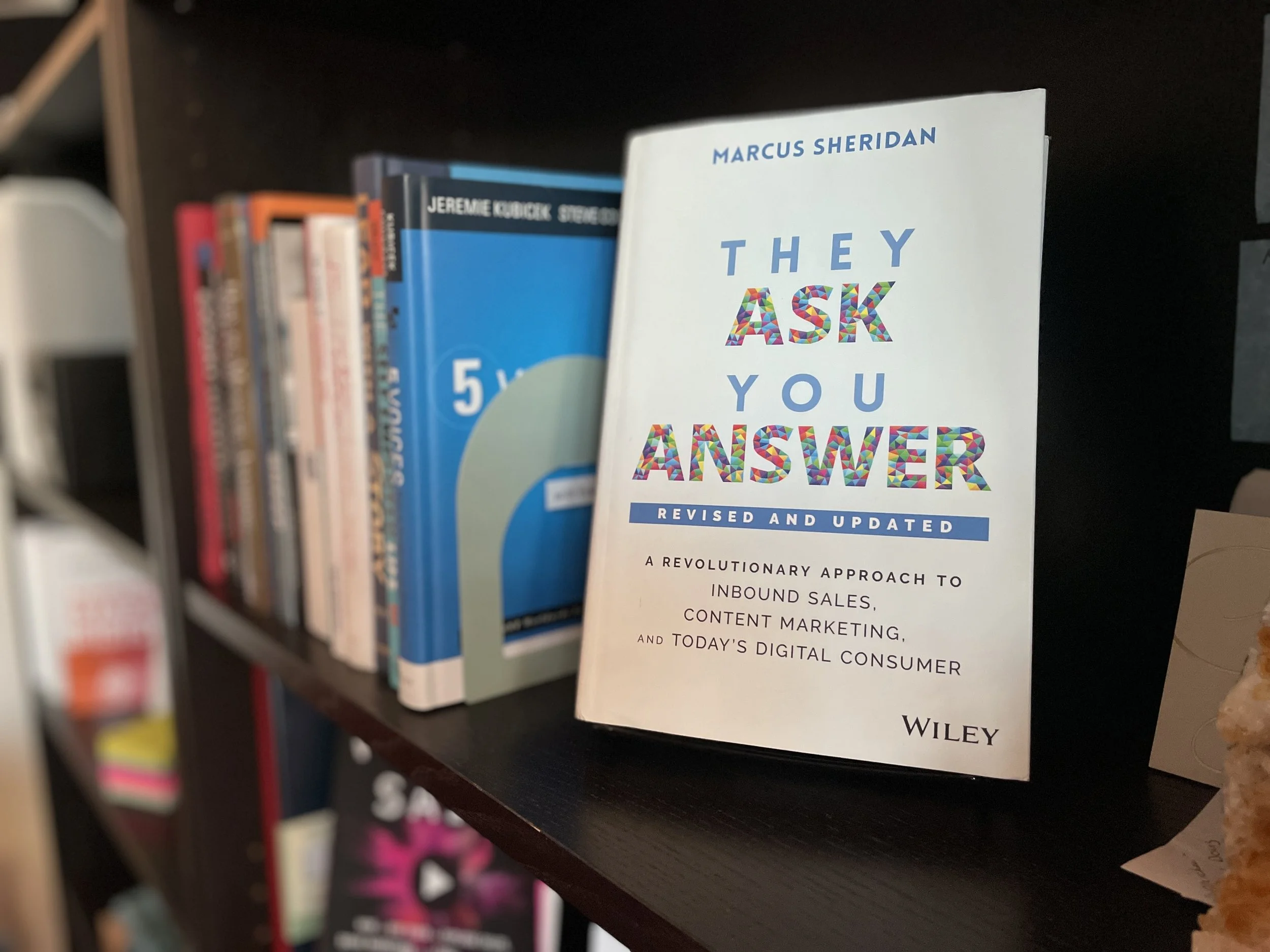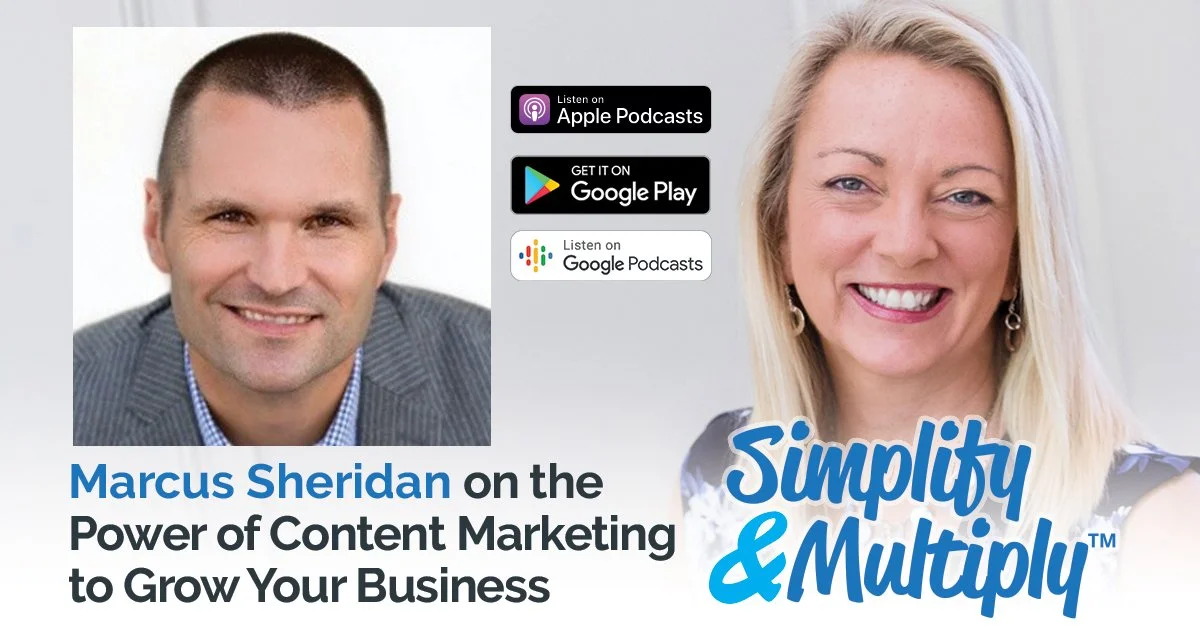Book Review: “They Ask You Answer” by Marcus Sheridan
Do you enjoy creating content?
I love writing. I love creating content that serves my audience and inspires people. However, many business owners struggle to create good content that’s relevant to their audience, and more importantly, drives revenue. So how does this work in today’s business marketing world? Here’s how I often see it executed in social media and elsewhere:
A business wants to beat its chest about how awesome they are. Features they have. Benefits they offer. Competitive pricing, etc. thinking that those messages will make prospects swarm and buy and love their brand
The business creates ads, copy or landing pages that focus on the business brand, offerings and features, with the hopes of enticing buyers with one-click action to buy
The business has a tactical strategy (spray and pray) or no strategy for content marketing
The business wonders why their “content marketing” and “social media marketing” has low or no ROI, or worse yet, backfires and gives their brand a negative perception
Here’s how content marketing works effectively in today’s marketplace:
A business has a product/service offering that addresses a marketplace need and they are skilled at creating a clear message
The business has a marketing strategy that includes inbound marketing (the process of creating valuable content that creates awareness and builds trust, eventually leading to test-drives and purchases)
Their inbound marketing and interactions in social media channels answer their target customer’s questions because they have identified what their target customers want and how they conduct their research and buying process
What follows is like a snowball that rolls downhill—growth in trust and relationship building takes care of itself when content marketing is done with the customer in mind.
Yes, there are other factors such as customer experience, referrals, etc., but for this article, I want to talk about “top-of-funnel” marketing activities. Where you are building content for an audience that doesn’t know your brand and they are in the “fact-finding” phase of their buying process.
They Ask, You Answer goes into great detail about the latter scenario. Marcus has done a great job at putting a bit of science to this premise and why it’s so important. Here is a brief video that sums it up:
Before I read Marcus’s book, I understood the value of content marketing. I had been creating content for years, but after being presented with his approach, I adjusted how I wrote. I thought about my ideal client and who I was speaking to more deeply. I got in their heads. I interviewed them. I asked what they struggled with. I’d always done this to a degree, but now it was my starting-off point. I added more humanity and empathy to my content and the content topics. As a result of this empathy and understanding of my client’s experience and struggles, I felt called to be more vulnerable, open and straightforward about my own experiences. And the result? I felt better about how I was “putting myself out there.” I also was getting more engagement and responses to my content.
The measurement dilemma of content marketing
Many people complain about the justification of content marketing because it can be difficult to measure the value of it. Sometimes tracking a new buyer to the source of their first exposure to your brand is impossible. “Where did you first hear about us?” “Oh, I don’t remember. Maybe a social media post or article? Can’t remember which one. You just seem to know what you’re talking about so I reached out.”
Measuring content marketing must be built into your strategy so you can track the results of engagement. I won’t go into measurement now, but Marcus covers some of this in his book and you should reverse-engineer your inbound marketing campaigns to have at least one form of KPI.
Another problem with content marketing
Content marketing is best sourced in-house, another important aspect from Marcus’s book. In the above video, Co-Owner of River Pools Jason Hughes, commented how he had to learn to be a better writer—to hone his writing and content creation skills. Bringing content marketing in-house is something many of my clients struggle with. I believe this is the most important aspect of effective content marketing. Why? Because YOU know your audience and product/service better than a content writer and always will.
When you outsource your content marketing it becomes very homogenized and lacks brand personality (unless you have an amazing content writer who can establish a brand tone and be totally dialed into that brand’s ideal audience’s needs). The reasons businesses outsource their content marketing include:
They are unskilled writers/content creators and have no clue what to write or where to post and promote what they write
They are too busy with service delivery to existing customers and problem solving internal operations
They have no strategy
They are too close to their own product/service to gain an objective or customer perspective
They don’t know or are detached from the questions their prospects are asking and the answers they need to know
They are unclear on their customer’s buying journey and what makes them choose one brand over another
They know they should do it to keep up with the Joneses, but they really don’t care (that’s typically a leadership position that holds that opinion)
They’d rather have some marketing company or contractor produce content for them to “have something out there” rather than put the time and budget into developing an inbound strategy that presences their brand and demonstrates attention for their customers’ needs
The last item in that list irks the heck out of me. For a few clients in the past, I have been that “outsourced contractor” to create content for them, and that is how I know how challenging it is to write for someone else. Many inexperienced content writers who are outsourced copywriters do this:
They get the topic from the client or guess on their own in the absence of a strategy or knowing what their customers are asking
They research online (this is how content gets homogenized)
They refer to other posts (to create backlinks, a not-so-white-hat hack) and summarize the research they’ve captured
They make assumptions about the buyer and/or the topic
They have no “next step” that nurtures the reader, they just “go for the kill” with a direct hard call to action to buy
Do you want your marketing content to be homogenized? Or do you want your content marketing to be effective at building your brand and serving your ideal customers? Yeah, I think I know the answer. After you read Marcus’s book, you’ll have a clearer understanding.
For you:
Reflect on how you’ve done content marketing (if you haven’t, why is that?) and review the content - is it about you or your client/customer? Take inventory of your approach, where and what you’re publishing, and what kind of results you’ve gotten from it. Are you promoting your content? That’s also a big part of it being successful. If you just post and hope, well, it will take a lot longer to get results. But if you’re promoting, sharing and getting your great customer-focused content out into the world, you’ll see faster results you can measure. And lastly, look at your strategy. Do you have a strategy for inbound marketing or are you just posting content for content’s sake? Get real with yourself about how you produce content because it’s one of the most powerful ways (and cheapest) to gain traction for your brand and make sales.
My conversation with Marcus Sheridan
Marcus was a guest on my Simplify & Multiply podcast and here’s the show:



